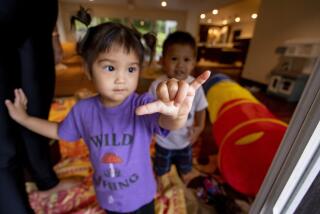Kwanzaa : Celebrating An African Past
- Share via
Monday marked the start of Kwanzaa, an African American holiday that celebrates culture, family and community. For seven days, through Jan. 1, African Americans will gather in their homes and at community events to reflect on the past year and to focus on the ideals that will enable them to lead prosperous and meaningful lives in the upcoming year. During this time, when “the edges of the year meet,” African Americans who observe Kwanzaa place their attention on the Nguzo Saba, or the seven principles. The name Kwanzaa is taken from the Swahili phrase matunda ya kwanza, which means first fruits. Swahili is the language of Kwanzaa and the principles are known by their Swahili names.
Kwanzaa ceremonies are joyful, hopeful events that celebrate the good in life. Traditional African clothing is typically worn to Kwanzaa gatherings, which also include African music and dance. Because Kwanzaa is a time to commemorate the past, poetry and spoken tributes are paid to people of African descent who have contributed much to black life and culture.
Kwanzaa is also a time of reverence to the Creator, an important element of Kwanzaa gatherings. *
The Seven Principles Each day of Kwanzaa corresponds to a different principle. Those who observe Kwanzaa greet each other with “Habari gani?” which means, “What’s the news?” The person being greeted responds with the principle of the day. 1. Umoja (Unity) 2. Kujichagulia (Self-determination) 3. Ujima (Collective work and responsibility) 4. Ujamaa (Cooperative economics) 5. Nia (Purpose) 6. Knumba (Creativity) 7. Imani (Faith)
History of the Holiday Kwanzaa is not a “black Christmas,” and is not specific to any religious group. In fact, it is not uncommon for families to celebrate Kwanzaa and other religious-based holidays.
Kwanzaa is based on African harvest ceremonies that celebrate the first fruits. The holiday was founded in 1966 by Maulana Karenga, who is now chairman of the black studies department at Cal State Long Beach.
An estimated 18 million people of African descent worldwide now celebrate Kwanzaa, most of them in the United States.
Symbols and Celebration The Flag: The bendera was created for people of African descent by Pan-Africanist leader Marcus Garvey. The red bar stands for the struggle for freedom, the black for unity and the green for future. *
Candles: Three red, one black and three green, they represent the seven principles. Each night of Kwanzaa, a different candle is lit, beginning with black, which is always in the center, and alternating from red to green. *
Kinara: With the candles, the candleholder is the heart of the Kwanzaa setting and symbolizes African ancestors. *
Muhindi: Corn represents children and the future. *
Mkeka: A mat that symbolizes history and tradition, the foundations upon which the community and family are built. *
Zawadi: Gifts signify the labor of parents and their love for their children. *
Mazao: Fruits and vegetables symbolize harvest and the rewards of labor. *
Kikombe cha umoja: The cup represents unity. Source: “KWANZAA” by A.P. Porter; Researched by JOCELYN Y. STEWART /Los Angeles Times
More to Read
Sign up for The Wild
We’ll help you find the best places to hike, bike and run, as well as the perfect silent spots for meditation and yoga.
You may occasionally receive promotional content from the Los Angeles Times.






